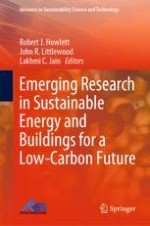This book contains an introduction and 20 studies, each describing a recent research investigation in the area of sustainable and resilient buildings, built environment infrastructure and renewable energy. Contributions are from many different countries of the world and on a range of topics, representing a sample of research within the ‘sustainable energy and buildings’ field. The book begins with chapters on the sustainable design of buildings, followed by descriptions of issues relating to the renovation, restoration and reconstruction of existing buildings, or in one case a railway wagon. The next part of the book covers factors that form barriers or impediments to low or zero carbon buildings, followed by studies of issues relating to policy and certification. There then follow four chapters on various topics related to sustainable buildings – undergraduate courses, insurance issues, biophilia relating to buildings and thermal conductivity measurement. There are several chapters relating to renewable energy, followed by two chapters with a sustainable transport theme, one relating to electric vehicles, and the other about a sustainable road infrastructure. The final chapter is on the manufacture of sustainable building components for the UK housing sector. The book is of use to engineers, scientists, researchers, practitioners, academics and all those who are interested to develop and use sustainability science and technology for the betterment of our planet and humankind, and to mitigate climate change reality.
